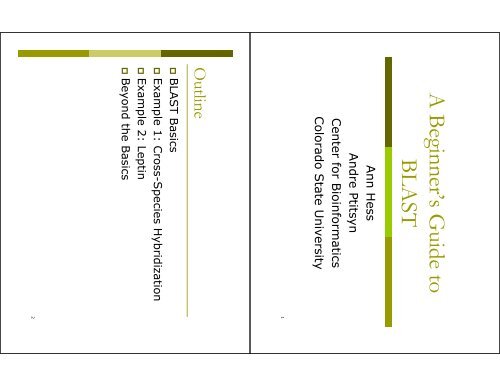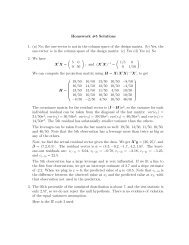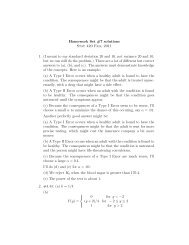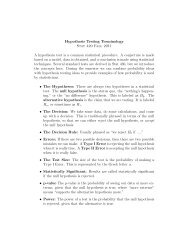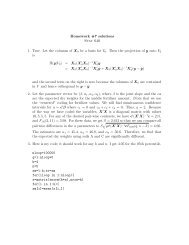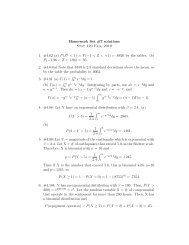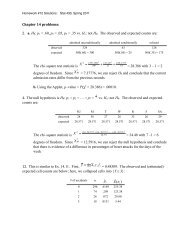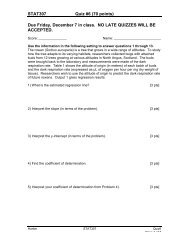Beginner's Guide to BLAST
Beginner's Guide to BLAST
Beginner's Guide to BLAST
Create successful ePaper yourself
Turn your PDF publications into a flip-book with our unique Google optimized e-Paper software.
A Beginner’s <strong>Guide</strong> <strong>to</strong><br />
<strong>BLAST</strong><br />
Ann Hess<br />
Andre Ptitsyn<br />
Center for Bioinformatics<br />
Colorado State University<br />
1<br />
Outline<br />
<strong>BLAST</strong> Basics<br />
Example 1: Cross-Species Hybridization<br />
Example 2: Leptin<br />
Beyond the Basics<br />
2
What is <strong>BLAST</strong>?<br />
Basic Local Alignment Search Tool, or<br />
<strong>BLAST</strong>, is an algorithm for comparing<br />
biological sequence information.<br />
It can handle both amino acid sequences<br />
(encoding proteins) or nucleotide<br />
sequences (from DNA).<br />
<strong>BLAST</strong> is one of the most widely used<br />
bioinformatics programs.<br />
It is actually a suite of programs for<br />
different applications.<br />
3<br />
The Central Dogma of Molecular Biology<br />
DNA remains in the<br />
nucleus.<br />
mRNA carries<br />
information from<br />
DNA and serve as<br />
templates that order<br />
different proteins.<br />
Proteins are<br />
responsible for cell<br />
function.<br />
4<br />
Image courtesy of Access Excellence @ the National Health Museum
DNA/Nucleotide Sequences<br />
DNA contains the genetic<br />
instructions used in the<br />
development and functioning of<br />
all living organisms.<br />
A nucleotide sequence consists<br />
of the letters A, C, G, and T,<br />
representing the four nucleotide<br />
subunits of a DNA strand -<br />
adenine, cy<strong>to</strong>sine, guanine and<br />
thymine.<br />
Base Pairing: A bonds only <strong>to</strong> T,<br />
and C bonds only <strong>to</strong> G<br />
5<br />
Proteins/Amino Acid Sequences<br />
Proteins are responsible for<br />
cell function.<br />
Amino acids are the<br />
building blocks of proteins.<br />
There are 20 amino acids:<br />
A, R, N, D, C, Q, E, G, H, I,<br />
L, K, M, F, P, S, T, W, Y, V<br />
A representation of<br />
the 3D structure of<br />
myoglobin.<br />
6
Who developed <strong>BLAST</strong>?<br />
Developed by Stephen Altschul, Warren<br />
Gish, David Lipman at the U.S. National<br />
Center for Biotechnology Information<br />
(NCBI), Webb Miller at Pennsylvania State<br />
University, and Gene Myers at the<br />
University of Arizona.<br />
The original paper “Basic local alignment<br />
search <strong>to</strong>ol” appeared in the Journal of<br />
Moelcular Biology in 1990.<br />
7<br />
Where can <strong>BLAST</strong> be found?<br />
The <strong>BLAST</strong> program can be accessed for<br />
free over the web or downloaded from<br />
NCBI.<br />
At CSU, <strong>BLAST</strong> can be accessed through<br />
the CBC cluster for faster running time.<br />
8
Web Access: www.ncbi.nlm.nih.gov<br />
9<br />
How does <strong>BLAST</strong> work?<br />
<br />
<strong>BLAST</strong> searches for similar subsequences<br />
between a query (or target) sequence<br />
and a sequence database:<br />
1. Scan database for exact matches of a small<br />
fixed length between the query and<br />
sequences database.<br />
2. Initiate extensions from these matches.<br />
3. Performs a gapped alignment between the<br />
query sequence and the database sequence<br />
using a variation of the Smith-Waterman<br />
algorithm.<br />
4. Statistically significant alignments are then<br />
displayed <strong>to</strong> the user.<br />
10
Scan Database…Initiate Extensions<br />
Protein <strong>BLAST</strong> requires two hits<br />
GTQITVEDLFYNI<br />
<br />
two neighborhood words<br />
Nucleotide <strong>BLAST</strong> requires exact matches<br />
ATCGCCATGCTTAATTGGGCTT<br />
<br />
exact word match<br />
11<br />
Global vs Local Alignment<br />
Seq 1<br />
Seq 2<br />
Global alignment<br />
Seq 1<br />
Seq 2<br />
Local alignment<br />
12
Why is <strong>BLAST</strong> used?<br />
Infer functional and evolutionary<br />
relationships between sequences<br />
Identify members of gene families<br />
Look for similar genes across species<br />
Select primers for PCR<br />
Annotate probes from a microarray<br />
experiment<br />
Search for SNPs<br />
Align sequences<br />
13<br />
Example 1: Cross Species Hybridization<br />
Campus researchers were<br />
interested in studying gene<br />
expression in common bean<br />
(Phaseolus vulgaris).<br />
However, they used the<br />
Affymetrix Soybean Genome<br />
Array because there is no<br />
phaseolus array available<br />
from Affymetrix.<br />
14
Query Sequence<br />
Suppose that probe set Gma.2019.1.S1_at was<br />
identified as representing a gene of interest.<br />
From the Affymetrix website we can find the<br />
target sequence:<br />
CCAAGTTCGAGACCCTTATTGACATTTCAGTGATAGAGATATTGTCAA<br />
GGCATGCTTCTGATGAGGTCTACCTTGGCCAAAGGGATAATCCAAATT<br />
GGACTACGGATTCAAAGGCATTGGAAGCTTTCAAAAAGTTTGGAAACA<br />
AACTGGCAGAAATTGAGGGAAAAATCACACAGAGGAACAATGATCCAA<br />
GTCTGAAAAGCCGACATGGGCCAGTTCAGCTTCCATACACATTGCTCC<br />
ATCGTTCAAGTGAGGAAGGGATGAGTTTCAAAGGAATTCCCAACAGTA<br />
TCTCCATCTAAAATGTGTGTGTGGTTTGCTTATCTATTGTG<br />
This sequence represents the gene for<br />
lipoxygenase in soybean. But does it match <strong>to</strong><br />
any known genes in Phaselous?<br />
15<br />
Nucleotide <strong>BLAST</strong> Search<br />
Enter Query Sequence: simply paste our<br />
query sequence in<strong>to</strong> the window.<br />
Choose Search Set:<br />
Database: Nucleotide Collection (nr/nt)<br />
Organism: Phaseolus vulgaris (taxid:3885)<br />
Program Selection/Algorithm:<br />
Megablast (highly similar sequences)<br />
Discontiguous mega blast (more dissimilar<br />
seqeunces)<br />
Blanstn (somewhat similar sequences)<br />
16
<strong>BLAST</strong> Results<br />
•Your search is limited <strong>to</strong> records matching entrez query: txid3885 [ORGN].<br />
Database: All GenBank+EMBL+DDBJ+PDB sequences (but no EST,STS,<br />
GSS,environmental samples or phase 0, 1 or 2 HTGS sequences)<br />
5,298,904 sequences; 20,720,589,268 <strong>to</strong>tal letters<br />
Query: Length=329<br />
Distribution of Blast Hits on the Query Sequence<br />
Query<br />
Sequence<br />
Hits<br />
17<br />
<strong>BLAST</strong> Results<br />
Sequences producing significant alignments:<br />
Accession Description Max score Total score<br />
Query<br />
coverage E value Max ident<br />
U76687.2 Phaseolus vulgaris lipoxygenase mRNA, complete cds 232 232 88% 7.00E-62 77%<br />
X63525.1 P.vulgaris loxA gene for lipoxygenase 219 219 90% 4.00E-58 76%<br />
AF234983.1 Phaseolus vulgaris lipoxygenase gene, complete cds 194 194 88% 2.00E-50 74%<br />
AF204210.2 Phaseolus vulgaris lipoxygenase (LOX4) mRNA, partial cds 181 181 87% 1.00E-46 73%<br />
X63521.1 P.vulgaris mRNA for lipoxygenase 170 170 82% 2.00E-43 73%<br />
18
(Brief) Interpretation of Results<br />
Accession: Sequence ID<br />
Max Score/Total Score: Score assigned by <strong>BLAST</strong>.<br />
In general the higher the score, the better the<br />
match between the query sequence and the<br />
sequence found in the database.<br />
Bit Score: Standardized Score<br />
Query Coverage: The percentage of the query<br />
sequence covered by each match.<br />
E value: The E value is the number the number<br />
of hits one can "expect" <strong>to</strong> see just by chance<br />
when searching a database of a particular size.<br />
Max ident: Percentage of exact matches<br />
19<br />
Top Match<br />
> gb|U76687.2|PVU76687 Phaseolus vulgaris lipoxygenase mRNA, complete cd<br />
Length=3038<br />
Score = 232 bits (256), Expect = 7e-62<br />
Identities = 226/291 (77%), Gaps = 0/291 (0%) Strand=Plus/Plus<br />
Query 9 GAGACCCTTATTGACATTTCAGTGATAGAGATATTGTCAAGGCATGCTTCTGATGAGGTC 68<br />
||| || || | ||| |||| |||||||||||||||||||| ||||||||||||||||||<br />
Sbjct 2581 GAGGCCATTGTGGACCTTTCTGTGATAGAGATATTGTCAAGACATGCTTCTGATGAGGTC 2640<br />
Query 69 TACCTTGGCCAAAGGGATAATCCAAATTGGACTACGGATTCAAAGGCATTGGAAGCTTTC 128<br />
|| ||||| || ||||| ||||| ||||||||| ||| ||||||| | |||| ||<br />
Sbjct 2641 TATCTTGGACAGAGGGACAATCCTAATTGGACTGATGATACAAAGGCTCTTCAAGCCTTT 2700<br />
Query 129 AAAAAGTTTGGAAACAAACTGGCAGAAATTGAGGGAAAAATCACACAGAGGAACAATGAT 188<br />
|||||||||||||||||||| ||||||||| || ||| | |||||||| ||<br />
Sbjct 2701 CAAAAGTTTGGAAACAAACTGAAGGAAATTGAGAATAAGATCTTAGGAAGGAACAACAAT 2760<br />
Query 189 CCAAGTCTGAAAAGCCGACATGGGCCAGTTCAGCTTCCATACACATTGCTCCATCGTTCA 248<br />
||||||| | || ||| |||||||||| || | || ||||| |||| | || | |<br />
Sbjct 2761 TCAAGTCTCAGAAACCGTGTTGGGCCAGTTAAGATGCCCTACACTGTGCTTCTTCCTACC 2820<br />
Query 249 AGTGAGGAAGGGATGAGTTTCAAAGGAATTCCCAACAGTATCTCCATCTAA 299<br />
||| ||||||| | | ||||| |||||| |||||||| ||||| || |||<br />
Sbjct 2821 AGTAAGGAAGGTCTCACTTTCAGAGGAATCCCCAACAGCATCTCTATTTAA 2871<br />
20
Second Match<br />
> emb|X63525.1|PVLOXA P.vulgaris loxA gene for lipoxygenase<br />
Length=8117<br />
Score = 219 bits (242), Expect = 4e-58<br />
Identities = 229/300 (76%), Gaps = 3/300 (1%) Strand=Plus/Plus<br />
Query 3 AAGTTCGAGACCCTTATTGACATTTCAGTGATAGAGATATTGTCAAGGCATGCTTCTGAT 62<br />
||| | ||| || || | ||| ||||||||||||||||||||||||| ||||||||||||<br />
Sbjct 7551 AAGGTTGAGGCCATTGTGGACCTTTCAGTGATAGAGATATTGTCAAGACATGCTTCTGAT 7610<br />
Query 63 GAGGTCTACCTTGGCCAAAGGGATAATCCAAATTGGACTACGGATTCAAAGGCATTGGAA 122<br />
|||||||| || || || ||||| |||||||||||||||| | ||| ||| | ||<br />
Sbjct 7611 GAGGTCTATCTAGGACAGAGGGACAATCCAAATTGGACTAATAACATAAAAGCACTTCAA 7670<br />
Query 123 GCTTTCAAAAAGTTTGGAAACAAACTGGCAGAAATTGAGGGAAAAATCACACAGAGGAAC 182<br />
|| || || | ||||||| | || ||| |||||||| | |||||||| |||||||<br />
Sbjct 7671 GCATTTAAGAGGTTTGGACAAAAGCTGAAGGAAATTGAAGAAAAAATCATGGGGAGGAAC 7730<br />
Query 183 AATGATCCAAGTCTGAAAAGCCGACATGGGCCAGTTCAGCTTCCATACACATTGCTCCAT 242<br />
|| ||| ||||||| | || ||| |||| |||||| || | || ||||| |||| | |<br />
Sbjct 7731 AAAGATTCAAGTCTTAGAAACCGTAATGGACCAGTTAAGATGCCCTACACTGTGCTTCTT 7790<br />
Query 243 CGTTCAAGT---GAGGAAGGGATGAGTTTCAAAGGAATTCCCAACAGTATCTCCATCTAA 299<br />
| | | || || ||||| | | ||| | ||||||||||||||| ||||| ||||||<br />
Sbjct 7791 CCTACTTGTGAAGATGAAGGCCTCACTTTTAGAGGAATTCCCAACAGCATCTCAATCTAA 7850<br />
21<br />
Example 1 Conclusions<br />
It appears that this probe set also<br />
represents a gene for lipoxygenase in<br />
common bean.<br />
22
Example 2: Leptin<br />
An article (“Positional cloning of the<br />
mouse obese gene and its human<br />
homologue”) published in Nature in<br />
1994 announced the discovery of the<br />
obese gene.<br />
Jeffrey Friedman and colleagues at<br />
Rockefeller University discovered that<br />
mice become fat when they lacked a<br />
single gene, ob.<br />
Friedman named the missing gene's<br />
product leptin, after the Greek word<br />
for thin (lep<strong>to</strong>s).<br />
Finding this mouse gene enabled<br />
researchers <strong>to</strong> discover a homologous<br />
gene in humans.<br />
23<br />
Finding the ob Gene<br />
The authors located the approximate<br />
region of the gene, then located genes in<br />
the region of interest.<br />
The ob gene was located and sequenced.<br />
“ob encodes a 4.5-kilobase (kb) adipose<br />
tissue messenger RNA with a highly<br />
conserved 167-amino-acid open reading<br />
frame.”<br />
24
Query Sequence<br />
We will use the 167-amino-acid sequence<br />
from the paper:<br />
MCWRPLCRFLWLWSYLSYVOAVPIQKVQDDTKTLIKTIVTRINDISHTOS<br />
VSAKQRVTGLDFIPGLHPILSLSKMDQTLAVYQQVLTSLPSQNVLQIAND<br />
LENLRDLLHLLAFSKSCSLPQTSGLQKPESLDGVLEASLYSTEVVALSRL<br />
QGSLQDILQQLDVSPEC<br />
At the time of publication, “A database<br />
search of the ob protein using the <strong>BLAST</strong><br />
program identified no significant homology<br />
<strong>to</strong> any sequences in GenBank.”<br />
25<br />
Protein <strong>BLAST</strong> Search<br />
Enter Query Sequence: simply paste our<br />
query sequence in<strong>to</strong> the window.<br />
Choose Search Set/Database:<br />
Non-redundant protein sequences (nr)<br />
Reference proteins (refseq_protein)<br />
Swissprot protein sequences (swissprot)<br />
Others<br />
Program Selection/Algorithm:<br />
blastp(protein-protein <strong>BLAST</strong>)<br />
PSI-<strong>BLAST</strong> (Position-Specific Iterated <strong>BLAST</strong>)<br />
PHI-<strong>BLAST</strong> (Pattern Hit Initiated <strong>BLAST</strong>)<br />
26
<strong>BLAST</strong> Results<br />
Database: NCBI Protein Reference Sequences<br />
3,168,478 sequences; 1,148,749,149 <strong>to</strong>tal letters<br />
Query: Length=167<br />
Distribution of Blast Hits on the Query Sequence<br />
Query<br />
Sequence<br />
Hits<br />
27<br />
<strong>BLAST</strong> Results<br />
Score E<br />
Sequences producing significant alignments: (Bits) Value<br />
ref|NP_032519.1| leptin [Mus musculus] 298 5e-80<br />
ref|NP_037208.1| leptin [Rattus norvegicus] 293 2e-78<br />
ref|NP_000221.1| leptin precursor [Homo sapiens] 257 1e-67<br />
ref|XP_519353.2| PREDICTED: leptin [Pan troglodytes] 256 3e-67<br />
ref|NP_001009850.1| leptin [Felis catus] 252 4e-66<br />
ref|NP_999005.1| leptin [Sus scrofa] 251 6e-66<br />
ref|NP_776353.2| leptin [Bos taurus] 248 8e-65<br />
ref|NP_001036220.1| leptin [Macaca mulatta] 247 1e-64<br />
ref|NP_001003070.1| leptin [Canis familiaris] 243 2e-63<br />
RefSeq Accession<br />
Numbers<br />
Sequence Descriptions<br />
28
Top Match<br />
>ref|NP_032519.1|<br />
Length=167<br />
leptin [Mus musculus]<br />
Score = 298 bits (763), Expect = 5e-80, Method: Composition-based stats.<br />
Identities = 165/167 (98%), Positives = 165/167 (98%), Gaps = 0/167 (0%)<br />
Query 1 MCWRPLCRFLWLWSYLSYVOAVPIQKVQDDTKTLIKTIVTRINDISHTOSVSAKQRVTGL 60<br />
MCWRPLCRFLWLWSYLSYV AVPIQKVQDDTKTLIKTIVTRINDISHT SVSAKQRVTGL<br />
Sbjct 1 MCWRPLCRFLWLWSYLSYVQAVPIQKVQDDTKTLIKTIVTRINDISHTQSVSAKQRVTGL 60<br />
Query 61 DFIPGLHPILSLSKMDQTLAVYQQVLTSLPSQNVLQIANDLENLRDLLHLLAFSKSCSLP 120<br />
DFIPGLHPILSLSKMDQTLAVYQQVLTSLPSQNVLQIANDLENLRDLLHLLAFSKSCSLP<br />
Sbjct 61 DFIPGLHPILSLSKMDQTLAVYQQVLTSLPSQNVLQIANDLENLRDLLHLLAFSKSCSLP 120<br />
Query 121 QTSGLQKPESLDGVLEASLYSTEVVALSRLQGSLQDILQQLDVSPEC 167<br />
QTSGLQKPESLDGVLEASLYSTEVVALSRLQGSLQDILQQLDVSPEC<br />
Sbjct 121 QTSGLQKPESLDGVLEASLYSTEVVALSRLQGSLQDILQQLDVSPEC 167<br />
29<br />
Second Match<br />
>ref|NP_037208.1|<br />
Length=167<br />
leptin [Rattus norvegicus]<br />
Score = 293 bits (749), Expect = 2e-78, Method: Composition-based stats.<br />
Identities = 159/167 (95%), Positives = 163/167 (97%), Gaps = 0/167 (0%)<br />
Query 1 MCWRPLCRFLWLWSYLSYVOAVPIQKVQDDTKTLIKTIVTRINDISHTOSVSAKQRVTGL 60<br />
MCWRPLCRFLWLWSYLSYV AVPI KVQDDTKTLIKTIVTRINDISHT SVSA+QRVTGL<br />
Sbjct 1 MCWRPLCRFLWLWSYLSYVQAVPIHKVQDDTKTLIKTIVTRINDISHTQSVSARQRVTGL 60<br />
Query 61 DFIPGLHPILSLSKMDQTLAVYQQVLTSLPSQNVLQIANDLENLRDLLHLLAFSKSCSLP 120<br />
DFIPGLHPILSLSKMDQTLAVYQQ+LTSLPSQNVLQIA+DLENLRDLLHLLAFSKSCSLP<br />
Sbjct 61 DFIPGLHPILSLSKMDQTLAVYQQILTSLPSQNVLQIAHDLENLRDLLHLLAFSKSCSLP 120<br />
Query 121 QTSGLQKPESLDGVLEASLYSTEVVALSRLQGSLQDILQQLDVSPEC 167<br />
QT GLQKPESLDGVLEASLYSTEVVALSRLQGSLQDILQQLD+SPEC<br />
Sbjct 121 QTRGLQKPESLDGVLEASLYSTEVVALSRLQGSLQDILQQLDLSPEC 167<br />
30
Third Match<br />
>ref|NP_000221.1|<br />
Length=167<br />
leptin precursor [Homo sapiens]<br />
Score = 257 bits (656), Expect = 1e-67, Method: Composition-based stats.<br />
Identities = 137/167 (82%), Positives = 150/167 (89%), Gaps = 0/167 (0%)<br />
Query 1 MCWRPLCRFLWLWSYLSYVOAVPIQKVQDDTKTLIKTIVTRINDISHTOSVSAKQRVTGL 60<br />
M W LC FLWLW YL YV AVPIQKVQDDTKTLIKTIVTRINDISHT SVS+KQ+VTGL<br />
Sbjct 1 MHWGTLCGFLWLWPYLFYVQAVPIQKVQDDTKTLIKTIVTRINDISHTQSVSSKQKVTGL 60<br />
Query 61 DFIPGLHPILSLSKMDQTLAVYQQVLTSLPSQNVLQIANDLENLRDLLHLLAFSKSCSLP 120<br />
DFIPGLHPIL+LSKMDQTLAVYQQ+LTS+PS+NV+QI+NDLENLRDLLH+LAFSKSC LP<br />
Sbjct 61 DFIPGLHPILTLSKMDQTLAVYQQILTSMPSRNVIQISNDLENLRDLLHVLAFSKSCHLP 120<br />
Query 121 QTSGLQKPESLDGVLEASLYSTEVVALSRLQGSLQDILQQLDVSPEC 167<br />
SGL+ +SL GVLEAS YSTEVVALSRLQGSLQD+L QLD+SP C<br />
Sbjct 121 WASGLETLDSLGGVLEASGYSTEVVALSRLQGSLQDMLWQLDLSPGC 167<br />
31<br />
More Distant Match<br />
>ref|NP_878565.1| exonuclease V, beta chain [Candidatus Blochmannia floridanus]<br />
Length=1208<br />
Score = 35.0 bits (79), Expect = 0.95, Method: Composition-based stats.<br />
Identities = 24/76 (31%), Positives = 36/76 (47%), Gaps = 5/76 (6%)<br />
Query 41 RINDISHTOSVSAKQRVTGLDFIPGLHPILSLSKMDQTLAVYQQVLTSLPSQNVLQIAN- 99<br />
R ND H +S + GL+F P +S + + Q++L S P N+LQ ++<br />
Sbjct 734 RFNDDHHLIKISTIHQSKGLEFPITYLPFISCYTNTKRFSNNQKILQSTPYANLLQSSST 793<br />
Query 100 ----DLENLRDLLHLL 111<br />
DLE L + L LL<br />
Sbjct 794 LDFFDLERLSEDLRLL 809<br />
32
Amino Acid Substitution Matrices<br />
PAM Matrices (Percent Accepted Mutation)<br />
<br />
Calculated by observing the differences in closely related<br />
proteins<br />
BLOSUM Matrices (BLOck SUbstitution Matrices)<br />
<br />
<br />
<br />
Constructed using multiple alignments of evolutionarily<br />
divergent proteins<br />
Probabilities are computed by looking at "blocks" of<br />
conserved sequences found in multiple protein<br />
alignments<br />
The <strong>BLAST</strong> default BLOSUM62 matrix is calculated from<br />
observed substitutions between proteins that share 62%<br />
sequence identity or more<br />
Position Specific Score Matrices (PSSMs) are used<br />
for PSI-<strong>BLAST</strong><br />
33<br />
BLOSUM62<br />
A 4<br />
R -1 5<br />
N -2 0 6<br />
D -2 -2 1 6<br />
C 0 -3 -3 -3 9<br />
Q -1 1 0 0 -3 5<br />
E -1 0 0 2 -4 2 5<br />
G 0 -2 0 -1 -3 -2 -2 6<br />
H -2 0 1 -1 -3 0 0 -2 8<br />
I -1 -3 -3 -3 -1 -3 -3 -4 -3 4<br />
L -1 -2 -3 -4 -1 -2 -3 -4 -3 2 4<br />
K -1 2 0 -1 -3 1 1 -2 -1 -3 -2 5<br />
M -1 -1 -2 -3 -1 0 -2 -3 -2 1 2 -1 5<br />
F -2 -3 -3 -3 -2 -3 -3 -3 -1 0 0 -3 0 6<br />
P -1 Positive -2 -2 -1 for -3 more -1 -1 likely -2 -2 substitutions<br />
-3 -3 -1 -2 -4 7<br />
S 1 -1 1 0 -1 0 0 0 -1 -2 -2 0 -1 -2 -1 4<br />
T 0 -1 0 -1 -1 -1 -1 -2 -2 -1 -1 -1 -1 -2 -1 1 5<br />
W -3 -3 -4 -4 -2 -2 -3 -2 -2 -3 -2 -3 -1 1 -4 -3 -2 11<br />
Y -2 -2 -2 -3 -2 -1 -2 -3 2 -1 -1 -2 -1 3 -3 -2 -2 2 7<br />
V 0 -3 -3 -3 -1 -2 -2 -3 -3 3 1 -2 1 -1 -2 -2 0 -3 -1 4<br />
A Negative R N D C for Q less E G likely H I substitutions<br />
L K M F P S T W Y V<br />
Common amino acids have low weights<br />
Rare amino acids have high weights<br />
34
Example 2 Conclusions<br />
Homologs <strong>to</strong> leptin have been identified in<br />
many other species besides mice.<br />
35<br />
Options for Advanced Blasting: Nucleotide<br />
Many of the algorithm parameters can be<br />
adjusted:<br />
Word Size<br />
Scoring System and Gap Costs<br />
Expect Threshold<br />
Filtering: Filtering can eliminate statistically<br />
significant but biologically uninteresting<br />
reports from the blast output<br />
Low Complexity Regions (Ex: AAATAAAAAAAAT)<br />
Species Specific Repeats<br />
36
Options for Advanced Blasting: Protein<br />
Many of the algorithm parameters can be<br />
adjusted:<br />
Word Size<br />
Substitution Matrices:<br />
- PAM30, PAM70<br />
- BLOSUM45, BLOSUM62, BLOSUM80<br />
Gap Costs<br />
Expect Threshold<br />
Filtering<br />
37<br />
Other <strong>BLAST</strong> Programs<br />
Megablast (for Nucleotide sequences) is<br />
intended for comparing a query <strong>to</strong> closely<br />
related sequences but is very fast.<br />
PSI (Position-Specific Iterated) <strong>BLAST</strong><br />
(for Protein sequences) can be used <strong>to</strong><br />
find distant relatives of a protein.<br />
mpi<strong>BLAST</strong> segments the <strong>BLAST</strong> database<br />
and distributes it across cluster nodes.<br />
38
Specialized <strong>BLAST</strong> Programs<br />
Search for SNPs (Single Nucleotide<br />
Polymorphisms). A SNP is a DNA sequence<br />
variation occurring when a single<br />
nucleotide differs between members of a<br />
species (or between paired chromosomes<br />
in an individual)<br />
Find sequences with gene expression<br />
profiles.<br />
Align two sequences.<br />
Find conserved domains in a sequence.<br />
39<br />
Alternatives <strong>to</strong> <strong>BLAST</strong><br />
BLAT (<strong>BLAST</strong> Like Alignment Tool) is much faster<br />
than <strong>BLAST</strong>, but less sensitive.<br />
<strong>BLAST</strong>Z is a multiple sequence alignment<br />
program.<br />
PatternHunter is commercial homology search<br />
software that is significantly faster than <strong>BLAST</strong>.<br />
HMMER uses hidden Markov models <strong>to</strong> do<br />
sensitive database searching.<br />
FASTA is a DNA and protein sequence alignment<br />
software package.<br />
40


